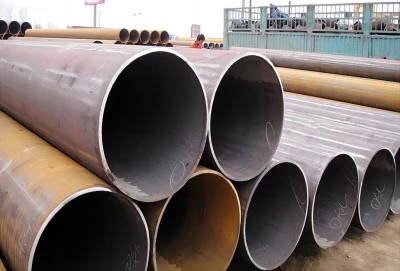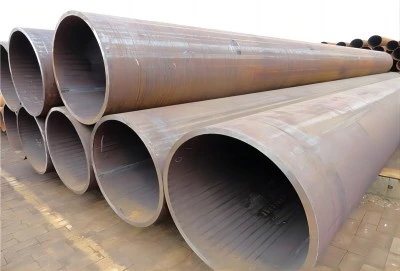Double seam welded pipes are widely used in various industries due to their strength, durability, and cost-effectiveness. However, like any industrial component, these pipes require proper maintenance and care to ensure their longevity and optimal performance. In this comprehensive guide, we'll explore essential maintenance tips, inspection techniques, corrosion prevention strategies, and how routine upkeep can significantly extend the lifespan of your welded pipes.
|
|
|
What are the maintenance tips for double seam welded pipe?
Maintaining double seam welded pipes is crucial for ensuring their longevity and performance. Here are some essential maintenance tips to keep your pipes in top condition:
1. Regular Cleaning: Implement a routine cleaning schedule to remove debris, scale, and other contaminants that can accumulate inside the pipes. This can be done through various methods such as pigging, chemical cleaning, or high-pressure water jetting, depending on the pipe's size and the nature of the contaminants.
2. Coating Maintenance: The protective coating on double seam welded pipes plays a vital role in preventing corrosion. Regularly inspect the coating for any signs of wear, damage, or peeling. If any issues are detected, promptly repair or reapply the coating to maintain its protective properties.
3. Cathodic Protection: For underground or submerged pipes, implement and maintain a cathodic protection system. This electrochemical technique helps prevent corrosion by making the pipe surface the cathode of an electrochemical cell.
4. Proper Insulation: If the pipes are used in high-temperature applications, ensure that the insulation is intact and in good condition. Damaged insulation can lead to energy loss and potentially accelerate corrosion.
5. Monitoring and Documentation: Implement a robust monitoring system to track the pipe's performance, pressure levels, and flow rates. Keep detailed records of all maintenance activities, inspections, and any issues encountered. This documentation can be invaluable for identifying trends and predicting potential problems before they escalate.
By following these maintenance tips, you can significantly extend the life of your double seam welded pipes and ensure their optimal performance.
How to inspect double seam welded pipes for early damage?
Regular inspection of double seam welded pipes is crucial for identifying potential issues before they develop into serious problems. Here are some effective methods for inspecting these pipes:
1. Visual Inspection: This is the most basic yet essential form of inspection. Regularly examine the exterior of the pipes for any visible signs of damage, such as dents, cracks, or corrosion. Pay special attention to the weld seams, as these can be potential weak points.
2. Ultrasonic Testing: This non-destructive testing method uses high-frequency sound waves to detect internal flaws or measure the thickness of the pipe wall. It's particularly useful for identifying areas of corrosion or erosion that may not be visible from the outside.
3. Radiographic Testing: X-ray or gamma-ray imaging can reveal internal defects in the pipe, including in the weld seams. This method is especially useful for thicker pipes where ultrasonic testing might be less effective.
4. Magnetic Particle Inspection: This method is used to detect surface and near-surface defects in ferromagnetic materials. It's particularly effective for finding cracks or other discontinuities in the weld seams.
5. Eddy Current Testing: This technique can detect surface and near-surface defects, as well as variations in the composition and thickness of the pipe wall. It's particularly useful for inspecting non-ferromagnetic materials.
6. Hydrostatic Testing: This involves filling the pipe with water and pressurizing it to check for leaks or structural weaknesses. It's typically performed after initial installation or major repairs.
7. Acoustic Emission Testing: This method involves listening for and analyzing the sounds produced by defects when the pipe is under stress. It can detect active corrosion, cracking, and other forms of degradation.
Regular inspections using a combination of these methods can help you catch potential issues early, allowing for timely repairs and preventing costly failures.
What are the best practices for preventing corrosion in double seam welded pipes?
Corrosion is one of the primary threats to the integrity and longevity of double seam welded pipes. Implementing effective corrosion prevention strategies is crucial for maintaining the pipes' performance and extending their service life. Here are some best practices for preventing corrosion:
1. Proper Material Selection: Choose pipe materials that are appropriate for the intended application and environment. Consider factors such as the corrosivity of the fluid being transported, external environmental conditions, and potential galvanic interactions.
2. Protective Coatings: Apply high-quality protective coatings to both the interior and exterior of the pipes. These coatings create a barrier between the metal surface and corrosive elements. Common types include epoxy, polyurethane, and fusion-bonded epoxy coatings.
3. Cathodic Protection: Implement cathodic protection systems for pipes that are buried or submerged. This can be achieved through sacrificial anodes or impressed current systems, which prevent the electrochemical reactions that cause corrosion.
4. Control of Operating Conditions: Maintain appropriate flow rates and temperatures within the pipes. Stagnant conditions can lead to the accumulation of corrosive substances, while excessively high temperatures can accelerate corrosion processes.
5. Regular Cleaning: Implement a routine cleaning schedule to remove corrosive substances, scale, and debris that can accumulate inside the pipes. This can help prevent localized corrosion and maintain the efficiency of the system.
6. pH Control: Monitor and maintain the pH levels of the fluids transported through the pipes. Extreme pH levels (either highly acidic or alkaline) can accelerate corrosion.
7. Oxygen Scavenging: In closed systems, use oxygen scavengers to remove dissolved oxygen, which is a primary driver of corrosion in many environments.
8. Inhibitor Application: Use chemical inhibitors that can be added to the fluid to create a protective film on the pipe's interior surface, reducing the rate of corrosion.
9. Proper Welding Techniques: Ensure that all welds, especially the double seams, are properly executed. Poor welding can create areas of increased stress and potential weak points for corrosion to initiate.
10. Regular Inspections: Conduct regular inspections to identify any early signs of corrosion. This allows for timely intervention before significant damage occurs.
By implementing these best practices, you can significantly reduce the risk of corrosion in your double seam welded pipes, ensuring their longevity and reliable performance.
How does routine maintenance extend the lifespan of welded pipes?
Routine maintenance plays a crucial role in extending the lifespan of welded pipes, including double seam welded pipes. By implementing a comprehensive maintenance program, you can significantly enhance the durability, reliability, and performance of your piping systems. Here's how routine maintenance contributes to the longevity of welded pipes:
1. Early Detection of Issues: Regular inspections and monitoring allow for the early detection of potential problems such as corrosion, wear, or damage. By identifying these issues in their initial stages, you can address them before they escalate into more serious and costly problems.
2. Preservation of Structural Integrity: Routine cleaning and maintenance help preserve the structural integrity of the pipes. Removing scale, debris, and corrosive substances prevents the accumulation of materials that could weaken the pipe walls or accelerate corrosion.
3. Optimization of Operating Conditions: Regular maintenance includes monitoring and adjusting operating parameters such as pressure, flow rates, and temperature. Maintaining optimal conditions reduces stress on the pipes and prevents premature wear or damage.
4. Protection of Coatings and Linings: Routine inspections and maintenance of protective coatings and linings ensure that these crucial barriers remain intact. Promptly repairing or replacing damaged coatings prevents exposure of the base metal to corrosive elements.
5. Prevention of Catastrophic Failures: By addressing minor issues promptly, routine maintenance helps prevent catastrophic failures that could result in significant downtime, environmental damage, or safety hazards.
6. Extended Service Life: The cumulative effect of routine maintenance is a significant extension of the pipe's service life. Well-maintained pipes can often exceed their expected lifespan, providing a better return on investment.
7. Improved Performance: Regular maintenance ensures that pipes operate at peak efficiency. This can lead to reduced energy consumption, improved flow characteristics, and overall better system performance.
8. Cost-Effective Management: While routine maintenance does require ongoing investment, it is generally far more cost-effective than reactive maintenance or premature pipe replacement. It helps in avoiding unexpected breakdowns and the associated costs of emergency repairs.
9. Compliance with Regulations: Regular maintenance helps ensure that your piping systems remain in compliance with industry standards and regulatory requirements, avoiding potential fines or legal issues.
10. Data Collection for Future Planning: Routine maintenance provides valuable data on the performance and degradation of pipes over time. This information can be used to inform future design choices, material selection, and maintenance strategies.
By implementing a robust routine maintenance program, you can significantly extend the lifespan of your welded pipes, ensuring their reliability, safety, and cost-effectiveness over the long term.
Contact Longma Group
Proper maintenance and care are essential for ensuring their longevity, reliability, and optimal performance. By implementing regular inspections, effective corrosion prevention strategies, and a comprehensive routine maintenance program, you can significantly extend the lifespan of your piping systems and avoid costly failures.
At Longma Group, we understand the critical importance of maintaining and protecting your double seam welded pipes. Our team of experts is ready to assist you in developing and implementing effective maintenance strategies tailored to your specific needs. Whether you're looking for advice on inspection techniques, corrosion prevention methods, or comprehensive maintenance programs, we're here to help.
Don't let preventable issues compromise the integrity of your piping systems. Take proactive steps today to ensure the longevity and reliability of your pipes. Contact us at info@longma-group.com to learn more about how we can support your maintenance efforts and help you maximize the lifespan of your piping infrastructure. Let's work together to protect your investment and ensure the smooth operation of your systems for years to come.














